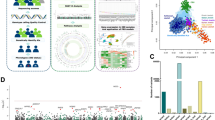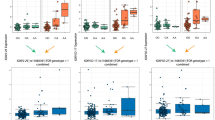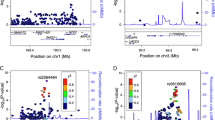Abstract
Genetic association studies have identified 215 risk loci for inflammatory bowel disease1,2,3,4,5,6,7,8, thereby uncovering fundamental aspects of its molecular biology. We performed a genome-wide association study of 25,305 individuals and conducted a meta-analysis with published summary statistics, yielding a total sample size of 59,957 subjects. We identified 25 new susceptibility loci, 3 of which contain integrin genes that encode proteins in pathways that have been identified as important therapeutic targets in inflammatory bowel disease. The associated variants are correlated with expression changes in response to immune stimulus at two of these genes (ITGA4 and ITGB8) and at previously implicated loci (ITGAL and ICAM1). In all four cases, the expression-increasing allele also increases disease risk. We also identified likely causal missense variants in a gene implicated in primary immune deficiency, PLCG2, and a negative regulator of inflammation, SLAMF8. Our results demonstrate that new associations at common variants continue to identify genes relevant to therapeutic target identification and prioritization.
This is a preview of subscription content, access via your institution
Access options
Access Nature and 54 other Nature Portfolio journals
Get Nature+, our best-value online-access subscription
$29.99 / 30 days
cancel any time
Subscribe to this journal
Receive 12 print issues and online access
$209.00 per year
only $17.42 per issue
Buy this article
- Purchase on Springer Link
- Instant access to full article PDF
Prices may be subject to local taxes which are calculated during checkout



Similar content being viewed by others
References
Liu, J.Z. et al. Association analyses identify 38 susceptibility loci for inflammatory bowel disease and highlight shared genetic risk across populations. Nat. Genet. 47, 979–986 (2015).
Parkes, M. et al. Sequence variants in the autophagy gene IRGM and multiple other replicating loci contribute to Crohn's disease susceptibility. Nat. Genet. 39, 830–832 (2007).
Yamazaki, K. et al. A genome-wide association study identifies 2 susceptibility loci for Crohn's disease in a Japanese population. Gastroenterology 144, 781–788 (2013).
Anderson, C.A. et al. Meta-analysis identifies 29 additional ulcerative colitis risk loci, increasing the number of confirmed associations to 47. Nat. Genet. 43, 246–252 (2011).
Kenny, E.E. et al. A genome-wide scan of Ashkenazi Jewish Crohn's disease suggests novel susceptibility loci. PLoS Genet. 8, e1002559 (2012).
Julià, A. et al. A genome-wide association study identifies a novel locus at 6q22.1 associated with ulcerative colitis. Hum. Mol. Genet. 23, 6927–6934 (2014).
Yang, S.-K. et al. Genome-wide association study of Crohn's disease in Koreans revealed three new susceptibility loci and common attributes of genetic susceptibility across ethnic populations. Gut 63, 80–87 (2014).
Ellinghaus, D. et al. Analysis of five chronic inflammatory diseases identifies 27 new associations and highlights disease-specific patterns at shared loci. Nat. Genet. 48, 510–518 (2016).
Luo, Y. et al. Exploring the genetic architecture of inflammatory bowel disease by whole-genome sequencing identifies association at ADCY7. Nat. Genet. http://dx.doi.org/10.1038/ng.3761 (2017).
Walter, K. et al. The UK10K project identifies rare variants in health and disease. Nature 526, 82–90 (2015).
1000 Genomes Project Consortium. A global reference for human genetic variation. Nature 526, 68–74 (2015).
Huang, H. et al. Association mapping of inflammatory bowel disease loci to single variant resolution. Preprint at bioRxiv http://dx.doi.org/10.1101/028688 (2015).
Ivanov, I.I. et al. The orphan nuclear receptor RORγt directs the differentiation program of proinflammatory IL-17+ T helper cells. Cell 126, 1121–1133 (2006).
Wang, G. et al. Migration of myeloid cells during inflammation is differentially regulated by the cell surface receptors Slamf1 and Slamf8. PLoS One 10, e0121968 (2015).
Wang, G. et al. Cutting edge: Slamf8 is a negative regulator of Nox2 activity in macrophages. J. Immunol. 188, 5829–5832 (2012).
Kircher, M. et al. A general framework for estimating the relative pathogenicity of human genetic variants. Nat. Genet. 46, 310–315 (2014).
Luci, C. et al. Influence of the transcription factor RORγt on the development of NKp46+ cell populations in gut and skin. Nat. Immunol. 10, 75–82 (2009).
Yang, Y. et al. Focused specificity of intestinal TH17 cells towards commensal bacterial antigens. Nature 510, 152–156 (2014).
Sawa, S. et al. RORγt+ innate lymphoid cells regulate intestinal homeostasis by integrating negative signals from the symbiotic microbiota. Nat. Immunol. 12, 320–326 (2011).
Gevers, D. et al. The treatment-naive microbiome in new-onset Crohn's disease. Cell Host Microbe 15, 382–392 (2014).
Withers, D.R. et al. Transient inhibition of ROR-γt therapeutically limits intestinal inflammation by reducing TH17 cells and preserving group 3 innate lymphoid cells. Nat. Med. 22, 319–323 (2016).
Fu, G., Chen, Y., Schuman, J., Wang, D. & Wen, R. Phospholipase Cγ2 plays a role in TCR signal transduction and T cell selection. J. Immunol. 189, 2326–2332 (2012).
Ombrello, M.J. et al. Cold urticaria, immunodeficiency, and autoimmunity related to PLCG2 deletions. N. Engl. J. Med. 366, 330–338 (2012).
Zhou, Q. et al. A hypermorphic missense mutation in PLCG2, encoding phospholipase Cγ2, causes a dominantly inherited autoinflammatory disease with immunodeficiency. Am. J. Hum. Genet. 91, 713–720 (2012).
Jostins, L. et al. Host–microbe interactions have shaped the genetic architecture of inflammatory bowel disease. Nature 491, 119–124 (2012).
Matute, J.D. et al. A new genetic subgroup of chronic granulomatous disease with autosomal recessive mutations in p40phox and selective defects in neutrophil NADPH oxidase activity. Blood 114, 3309–3315 (2009).
Rioux, J.D. et al. Genome-wide association study identifies new susceptibility loci for Crohn disease and implicates autophagy in disease pathogenesis. Nat. Genet. 39, 596–604 (2007).
Roberts, R.L. et al. Confirmation of association of IRGM and NCF4 with ileal Crohn's disease in a population-based cohort. Genes Immun. 9, 561–565 (2008).
Dendrou, C.A. et al. Resolving TYK2 locus genotype-to-phenotype differences in autoimmunity. Sci. Transl. Med. 8, 363ra149 (2016).
Hynes, R.O. Integrins: bidirectional, allosteric signaling machines. Cell 110, 673–687 (2002).
Sandborn, W.J. et al. Vedolizumab as induction and maintenance therapy for Crohn's disease. N. Engl. J. Med. 369, 711–721 (2013).
Feagan, B.G. et al. Vedolizumab as induction and maintenance therapy for ulcerative colitis. N. Engl. J. Med. 369, 699–710 (2013).
Vermeire, S. et al. Etrolizumab as induction therapy for ulcerative colitis: a randomised, controlled, phase 2 trial. Lancet 384, 309–318 (2014).
Hosten, T.A., Zhao, K., Han, H.Q., Liu, G. & He, X.H. Alicaforsen: an emerging therapeutic agent for ulcerative colitis and refractory pouchitis. Gastroenterol. Res. 7, 51–55 (2014).
James, D.G., Seo, D.H., Chen, J., Vemulapalli, C. & Stone, C.D. Efalizumab, a human monoclonal anti-CD11a antibody, in the treatment of moderate to severe Crohn's Disease: an open-label pilot study. Dig. Dis. Sci. 56, 1806–1810 (2011).
Sandborn, W.J. et al. Natalizumab induction and maintenance therapy for Crohn's disease. N. Engl. J. Med. 353, 1912–1925 (2005).
Carson, K.R. et al. Monoclonal antibody–associated progressive multifocal leucoencephalopathy in patients treated with rituximab, natalizumab, and efalizumab: a Review from the Research on Adverse Drug Events and Reports (RADAR) Project. Lancet Oncol. 10, 816–824 (2009).
Travis, M.A. & Sheppard, D. TGF-β activation and function in immunity. Annu. Rev. Immunol. 32, 51–82 (2014).
Travis, M.A. et al. Loss of integrin αvβ8 on dendritic cells causes autoimmunity and colitis in mice. Nature 449, 361–365 (2007).
Worthington, J.J. et al. Integrin αvβ8-mediated TGF-β activation by effector regulatory T cells is essential for suppression of T-cell-mediated inflammation. Immunity 42, 903–915 (2015).
Monteleone, G. et al. Mongersen, an oral SMAD7 antisense oligonucleotide, and Crohn's disease. N. Engl. J. Med. 372, 1104–1113 (2015).
Miceli-Richard, C. et al. CARD15 mutations in Blau syndrome. Nat. Genet. 29, 19–20 (2001).
Shah, T.S. et al. optiCall: a robust genotype-calling algorithm for rare, low-frequency and common variants. Bioinformatics 28, 1598–1603 (2012).
Durbin, R. Efficient haplotype matching and storage using the positional Burrows–Wheeler transform (PBWT). Bioinformatics 30, 1266–1272 (2014).
Bulik-Sullivan, B.K. et al. LD Score regression distinguishes confounding from polygenicity in genome-wide association studies. Nat. Genet. 47, 291–295 (2015).
Wakefield, J. Bayes factors for genome-wide association studies: comparison with P-values. Genet. Epidemiol. 33, 79–86 (2009).
Maller, J.B. et al. Bayesian refinement of association signals for 14 loci in 3 common diseases. Nat. Genet. 44, 1294–1301 (2012).
Zhernakova, D. et al. Identification of context-dependent expression quantitative trait loci in whole blood. Nat. Genet. http://dx.doi.org/10.1038/ng.3737 (2017).
Battle, A. et al. Characterizing the genetic basis of transcriptome diversity through RNA-sequencing of 922 individuals. Genome Res. 24, 14–24 (2014).
Monlong, J., Calvo, M., Ferreira, P.G. & Guigó, R. Identification of genetic variants associated with alternative splicing using sQTLseekeR. Nat. Commun. 5, 4698 (2014).
Ongen, H., Buil, A., Brown, A.A., Dermitzakis, E.T. & Delaneau, O. Fast and efficient QTL mapper for thousands of molecular phenotypes. Bioinformatics 32, 1479–1485 (2016).
Giambartolomei, C. et al. Bayesian test for colocalisation between pairs of genetic association studies using summary statistics. PLoS Genet. 10, e1004383 (2014).
Sandborn, W.J. et al. Ustekinumab induction and maintenance therapy in refractory Crohn's disease. N. Engl. J. Med. 367, 1519–1528 (2012).
Hanauer, S.B. et al. Maintenance infliximab for Crohn's disease: the ACCENT I randomised trial. Lancet 359, 1541–1549 (2002).
Colombel, J.-F. et al. Adalimumab for maintenance of clinical response and remission in patients with Crohn's disease: the CHARM trial. Gastroenterology 132, 52–65 (2007).
Schaefer, C.F. et al. PID: the Pathway Interaction Database. Nucleic Acids Res. 37, D674–D679 (2009).
Acknowledgements
We thank all individuals who contributed samples to the study. This work was co-funded by the Wellcome Trust (098051) and the Medical Research Council, UK (MR/J00314X/1). Case collections were supported by Crohn's and Colitis UK. K.M.d.L., L.M., C.A.L., Y.L., D.R., J.G.-A., N.J.P., C.A.A. and J.C.B. are supported by the Wellcome Trust (098051; 093885/Z/10/Z; 094491/Z/10/Z). K.M.d.L. is supported by a Woolf Fisher Trust scholarship. C.A.L. is a clinical lecturer funded by the NIHR. We thank A. Stanton for coordinating the patient recruitment at Guy's and St. Thomas'. We acknowledge support from the UK Department of Health via NIHR comprehensive Biomedical Research Centre awards to Guy's and St. Thomas' NHS Foundation Trust in partnership with King's College London and to Addenbrooke's Hospital, Cambridge, in partnership with the University of Cambridge. This research was also supported by the NIHR Newcastle Biomedical Research Centre. The UK Household Longitudinal Study is led by the Institute for Social and Economic Research at the University of Essex and funded by the Economic and Social Research Council. The survey was conducted by NatCen, and the genome-wide scan data were analyzed and deposited by the Wellcome Trust Sanger Institute. Information on how to access the data can be found on the Understanding Society website.
Author information
Authors and Affiliations
Contributions
K.M.d.L., L.M., Y.L., L.J., D.L.R., C.A.A. and S.-G.J. performed statistical analysis. K.M.d.L., L.M., Y.L., L.J., J.C.L., J.G.-A., S.-G.J., C.A.L., N.A.K. and C.A.A. analyzed the data. G.H., E.R.N., C.E., C.M., A.S., D.C.W., M.T., A.H., C.G.M., M.P., W.G.M., C.W.L., H.U., C.H., N.J.P., T.A., J.C.M., J. Satsangi, J. Sanderson and P.H. contributed samples and/or materials. C.A.A., J.C.B., K.M.d.L., L.M., J.C.L., C.G.M., M.P., C.A.L., N.A.K., Y.L. and P.H. wrote the manuscript. J.C.B., C.A.A., J.C.M., M.P., C.W.L., T.A. and N.J.P. conceived and designed experiments.
Corresponding authors
Ethics declarations
Competing interests
The authors declare no competing financial interests.
Integrated supplementary information
Supplementary Figure 1 Manhattan plot of meta-analysis summary statistics for Crohn’s disease.
Loci previously associated with IBD are shown in orange, those previously associated with Crohn’s disease are shown in red and those previously associated with ulcerative colitis are shown in dark blue.
Supplementary Figure 2 Manhattan plot of meta-analysis summary statistics for ulcerative colitis.
Loci previously associated with IBD are shown in orange, those previously associated with Crohn’s disease are shown in red and those previously associated with ulcerative colitis are shown in dark blue.
Supplementary Figure 3 Manhattan plot of meta-analysis summary statistics for inflammatory bowel disease.
Loci previously associated with IBD are shown in orange, those previously associated with Crohn’s disease are shown in red and those previously associated with ulcerative colitis are shown in dark blue.
Supplementary Figure 4 Cluster plots for variant rs34687326.
Cluster plots were created for directly genotyped variants in loci that were precisely fine-mapped using individuals in the new UKIBDGC GWAS.
Supplementary Figure 5 Cluster plots for variant rs1143687.
Cluster plots were created for directly genotyped variants in loci that were precisely fine-mapped using individuals in the new UKIBDGC GWAS.
Supplementary Figure 6 Cluster plots for variant rs4821544.
Cluster plots were created for directly genotyped variants in loci that were precisely fine-mapped using individuals in the new UKIBDGC GWAS.
Supplementary Figure 7 Effect size of variant rs4821544 when stratified by disease location.
The effect of this variant that was fine-mapped well, which is intronic in NCF4, is consistently stronger in small bowel than in large bowel disease.
Supplementary information
Supplementary Text and Figures
Supplementary Figures 1–7 (PDF 1206 kb)
Supplementary Table 1
GWAS, sequencing and summary statistic data sets included in this study. (XLSX 32 kb)
Supplementary Table 2
Meta-analysis association statistics at all 241 known and novel loci. (XLSX 74 kb)
Supplementary Table 3
Fine-mapping summary statistics for 65 loci where fine-mapping was attempted. (XLSX 116 kb)
Supplementary Table 4
Enrichment of known IBD loci for genes associated with Mendelian disorders of inflammation and immunity. (XLSX 54 kb)
Supplementary Table 5
Colocalization between meta-analysis association statistics and monocyte stimulus response eQTLs. (XLSX 9 kb)
Supplementary Table 6
IBD-associated loci containing genes in immune pathways related to classes of approved therapeutics. (XLSX 9 kb)
Supplementary Table 7
Overlap of 25 novel IBD-associated loci with known eQTL signals. (XLSX 297 kb)
Rights and permissions
About this article
Cite this article
de Lange, K., Moutsianas, L., Lee, J. et al. Genome-wide association study implicates immune activation of multiple integrin genes in inflammatory bowel disease. Nat Genet 49, 256–261 (2017). https://doi.org/10.1038/ng.3760
Received:
Accepted:
Published:
Issue Date:
DOI: https://doi.org/10.1038/ng.3760
This article is cited by
-
Association between inflammatory bowel disease and cancer risk: evidence triangulation from genetic correlation, Mendelian randomization, and colocalization analyses across East Asian and European populations
BMC Medicine (2024)
-
Lipid-lowering drugs and inflammatory bowel disease’s risk: a drug-target Mendelian randomization study
Diabetology & Metabolic Syndrome (2024)
-
Shared genetic architecture between autoimmune disorders and B-cell acute lymphoblastic leukemia: insights from large-scale genome-wide cross-trait analysis
BMC Medicine (2024)
-
Correlations between genetically predicted lipid-lowering drug targets and inflammatory bowel disease
Lipids in Health and Disease (2024)
-
FORGEdb: a tool for identifying candidate functional variants and uncovering target genes and mechanisms for complex diseases
Genome Biology (2024)



